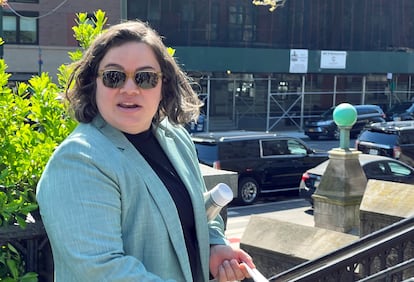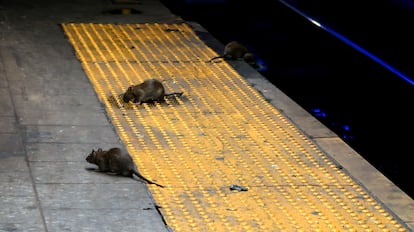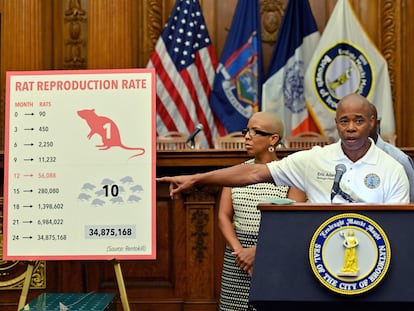‘There’s a new sheriff in town’: New York appoints ‘rat czar’ to tackle rodent scourge
Kathleen Corradi, a former elementary school teacher who developed the Zero Waste Schools program, has been appointed to lead the fight against ‘the real enemy: New York City’s relentless rat population’


New York’s four million rats — one for every four inhabitants of the city, according to estimations that may veer toward the optimistic — have their days numbered. As of April 12, the Big Apple has its new “rat czar,” Kathleen Corradi, whose official title is director of rodent mitigation. The post was created by New York Mayor Eric Adams, who has a self-professed phobia of rodents. “There’s NOTHING I hate more than rats,” Adams posted on Twitter when announcing the city’s search for a ratslayer-in-chief. The mayor is far from alone in a city where it is as common to come across a rat as it is to find other passengers in a subway car. According to a persistent urban legend, there are as many rats in New York as there are people: almost nine million, hence skepticism over the more modest official calculations. Neither is the problem a recent one. The English novelist Charles Dickens complained about the proliferation of rats when he visited the city in 1842.
Corradi is a former elementary school teacher who developed New York City’s Zero Waste Schools program while working at the New York Department of Education’s Office of Sustainability, which included tackling the rat problem around the city’s public schools. According to The New York Times, she will be paid a salary of $155,000 a year. According to the job description, Corradi will be charged with displaying “the drive, determination and killer instinct needed to fight the real enemy: New York City’s relentless rat population.”
The adventures of rats in New York — the most Instagrammed city in the world — have provided big business on social media. A video showing a rodent hauling a slice of pizza along the stairs of a subway station went viral in 2015, much to the chagrin of the city’s tourism department. “New York may be famous for the Pizza Rat, but rats, and the conditions that help them thrive will no longer be tolerated — no more dirty curbs, unmanaged spaces, or brazen burrowing,” Corradi said in a statement while announcing that there is a “a new sheriff in town who will send those rats packing.”

Rats abound in New York’s suburbs, but also in parks and in playgrounds designed for dogs and children, in the basement of buildings, storage areas in stores and the back rooms of restaurants. They are so ubiquitous that, after numerous attempts to stamp them out, Adams made the announcement four months ago of the nationwide search for a rat czar.
Among recent attempts to keep rats in check was a municipal notice issued on April 1 urging residents to take the garbage out late in the afternoon, to prevent bags from multiplying on the sidewalks. Many garbage cans in the city are made of plastic or brass with lids that provide little in the way of difficulty for the rodents. In addition, the closure of restaurants during the coronavirus pandemic cut off an important source of food for rats, leading them to develop a more aggressive nature that they have retained: they stop at nothing.
While the debate as to the ethics of culling millions of rats in New York is gaining momentum — some scientists have also suggested that it would break the natural chain of species — Mayor Adams is managing in the meantime to adapt the city to his aversions and his preferences. A committed vegan, the former police officer claims that his change of diet restored his health and vitality after he was diagnosed with diabetes and last year he instituted the so-called Plant-Powered Friday on school menus, which offers a vegan dish as the primary item on the menu as a test run for the introduction of dietary alternatives.
Sign up for our weekly newsletter to get more English-language news coverage from EL PAÍS USA Edition
Tu suscripción se está usando en otro dispositivo
¿Quieres añadir otro usuario a tu suscripción?
Si continúas leyendo en este dispositivo, no se podrá leer en el otro.
FlechaTu suscripción se está usando en otro dispositivo y solo puedes acceder a EL PAÍS desde un dispositivo a la vez.
Si quieres compartir tu cuenta, cambia tu suscripción a la modalidad Premium, así podrás añadir otro usuario. Cada uno accederá con su propia cuenta de email, lo que os permitirá personalizar vuestra experiencia en EL PAÍS.
¿Tienes una suscripción de empresa? Accede aquí para contratar más cuentas.
En el caso de no saber quién está usando tu cuenta, te recomendamos cambiar tu contraseña aquí.
Si decides continuar compartiendo tu cuenta, este mensaje se mostrará en tu dispositivo y en el de la otra persona que está usando tu cuenta de forma indefinida, afectando a tu experiencia de lectura. Puedes consultar aquí los términos y condiciones de la suscripción digital.
More information
Archived In
Últimas noticias
Most viewed
- Oona Chaplin: ‘I told James Cameron that I was living in a treehouse and starting a permaculture project with a friend’
- Reinhard Genzel, Nobel laureate in physics: ‘One-minute videos will never give you the truth’
- Sinaloa Cartel war is taking its toll on Los Chapitos
- Why the price of coffee has skyrocketed: from Brazilian plantations to specialty coffee houses
- Silver prices are going crazy: This is what’s fueling the rally










































